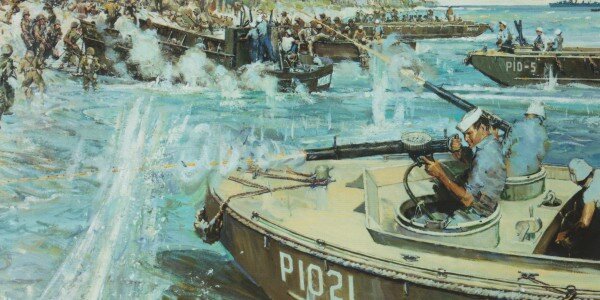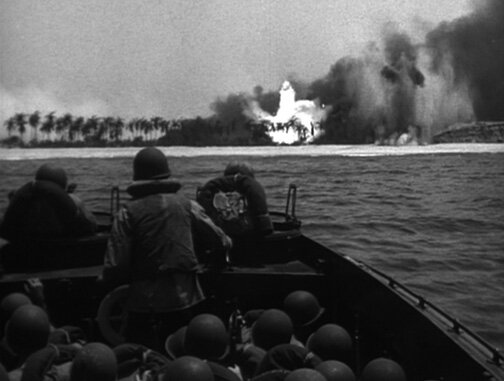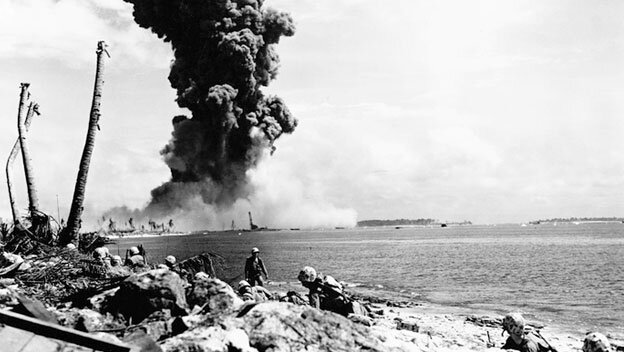Douglas Munro
The motto of the United States Coast Guard is Semper Paratus. It means “Always Ready.”
So on the afternoon of September 27, 1942, when a fatally-wounded Navy Coxswain named Samuel B. Roberts slammed his shot-to-shit Higgins Boat landing craft into the beach at Lunga Point Base at 20 miles an hour, it didn’t take long for Coast Guard Signalman First Class Douglas Munro to grab his shit and spring into action.
In the wreckage on the beach, Coast Guard Petty Officer Ray Evans muscled his way out of the smashed Higgins boat as the crew of Lunga Point Base ran towards him. The news was dire – Evans’ boat had stayed behind to help evacuate wounded from a Marine Corps attack on Japanese positions along Guadalcanal’s Matanikau River, but the enemy resistance had been way stronger than expected. Enemy troops were on the beaches and were maneuvering quickly, and if the Coast Guard didn’t do something soon there were going to be three companies of Marines in a hell of a lot of shit.
Within minutes, Signalman First Class Douglas Munro was slamming a belt of .30 cal into a ship-mounted Lewis machine gun, screaming full-speed-ahead towards the warzone at the head of a column of five D-Day-style Landing Craft. He knew the risks, he volunteered for the mission, and he was going to get those Marines the fuck out of there or die trying.
He heard the explosions and gunshots before he could even see the landing zone.
The Battle for Guadalcanal in the Fall of 1942 was America’s first real ground warfare showdown with the Empire of Japan. This small sandy Solomon Island was the first stop on America Revenge Island-Hopping World Tour 1942, and capturing the Japanese airfield on the tiny South Pacific island would give the United States a good jumping-off point for airstrikes against Japanese bases all throughout the pacific.
So, in August 1942, several hundred American warships began deploying tens of thousands of Marines to seize the island and hold it against enemy counterattacks.
Douglas Munro was a 22 year-old Coast Guardsman from Cle Elum, Washington who kind of looks like Ryan Gosling in some pictures, and in the opening hours of the invasion he piloted one of the LCPs (Landing Craft, Personnel) that dropped troops into the engagement site. Under the pounding cover of heavy naval artillery , Munro maneuvered a 36-foot-long, 225-horsepower, shallow-draft plywood barge full ahead at 12 knots, knowing full well that the lives of 36 Marines and 3 other Coast Guard crewmen were in his hands.
Munro’s drop site wasn’t on Guadalcanal itself, but on the nearby island of Tulagi, which was way less heavily-defended than Guadalcanal. With his LCP’s gunners laying down covering fire from two .30-cals and U.S. Navy warships bombing artillery shells overhead, he reached the beach and safely unloaded a platoon of Marines who immediately stormed ahead to secure the position.
It would be the young Signalman’s first taste of combat, but certainly not his last.
Serving on a couple different ships off the coast of Guadalcanal, one of Munro’s primary missions was to search-and-rescue for downed American pilots. Now, pulling an unconscious aviator out of a sinking aircraft is no fucking picnic to begin with, but shit got really bad for Monroe on the evening of September 20, 1942, when he was commanding a mission to locate and rescue the crew of a U.S. Navy SBD Dauntless dive bomber that had ditched in the water just off the coast of the island. With dusk approaching, Munro and three other men used a shallow-bottomed boat to comb the waters for the wreckage, only to be greeted by a large volume of Japanese machine gun fire from defensive positions along the coast. With bullets splashing up the water all around him, Munro refused to back down and give up the search – he returned fire, escaped the ambush, and continued his mission. He did eventually track down the smashed fuselage of the Dauntless, and even though the crew had already been rescued by a pontoon boat before Munro arrived that doesn’t in any way diminish how fucking ballsy this guy was to push on and try to save lives even while Japanese heavy machine gun bullets were whizzing all around his fucking head.
Munro would be cited for bravery by his commanders for this mission, but it would just be a footnote in his service record compared to what was to follow.
Tulagi Island fell, but the Americans were running into some serious shit on Guadalcanal. Fueled by the infamous “Tokyo Express”, a badass fleet of Japanese transports that funneled an almost endless stream of men, weaponry, and equipment onto the island, the defenders were digging in their fucking samurai swords and fighting hard for every inch of land on the island.
With the American attack starting to stall, a daring mission was devised by legendary Marine Corps badass Chesty Puller. Puller was a dude so goddamn hardcore that the first time he saw a flamethrower he angrily demanded “Where the hell do you put the bayonet?!”, and this guy wasn’t about to screw around with trench warfare when he could be out there plowing a size ten steel-toed combat boot up the urethras of his enemies . Puller took three companies of the 7th Marines (around 500 guys) and deployed them in an amphibious assault around the north side of Guadalcanal Island. Douglas Munro was in command of the operation for the Coast Guard, loading the 500 Marines onto ten Higgins Boats and unloading them onto a quiet sandy beach where they encountered zero enemy resistance.
The Marines deployed to the beach with no problem and the Coast Guard boats headed back to base to refuel. Then, suddenly, the crack of Arisaka Type 99s started ripping out through the dense jungle, coming at the Marines from seemingly ever direction at once. The battalion commanding officer and one company commander were killed in the initial barrage of rifle, machine gun, and mortar fire, and the jungle lit up like a fucking Vietnam movie as enemy soldiers opened up on the Marines.
Most of the Higgins Boats had reached base, but one had stayed behind – a boat piloted by Navy Coxswain Samuel B. Roberts. Roberts’ ship was raked with machine gun fire, wounding him multiple times, but he still opened up the throttle and sped back to base as quickly as he could. Despite losing massive amounts of blood, Roberts reached the USCG base, told everyone what was going on, and then died pretty much immediately.
The Coast Guard knew that there were Marines out there, trapped in a killzone with nowhere to fall back. If those boys were going to get out of there alive, their only hope was the United States Coast Guard and Douglas Munro.
Douglas Munro commanded the lead Higgins Boat, ripping up the wake as he sped full-throttle towards the bullet-riddled beach. Mortars kicked up spires of water all around him, gunshots whizzed past his head or pinged off the ship’s hull, but he never once considered turning back. A Coxswain took over piloting the boat as Munro climbed over the bow, jumping into the boat’s Lewis Machine Gun mount. He racked the slide, started cranking out full-auto machine gun fire, and ordered his pilot to get right up on the beach.
(As he did this, a familiar sound of ship artillery fire came whizzing over his head from the sea, crashing into Japanese positions in the jungle. Chesty Puller, hearing about the enemy ambush, had commandeered the U.S. Navy Destroyer USS Monssen – without any authority to do so – and ordered it to open fire into the jungle.)
The Coast Guard began loading Marines back onto the Higgins Boats, but the Japanese were so close that they were machine gunning all throughout the beachhead – think of it as kind of like the D-Day landings, only the guys are getting killed while trying to board the boats instead of attacking off them. Munro saw what was going on, realized that the Marines were going to get slaughtered if he didn’t do something, and did one of the most badass, selfless, and heroic things you can imagine –
He ordered his pilot to wedge the Higgins boat onto the beach so that it blocked the enemy machine gun fire and would serve as cover for the wounded Marines boarding the evac boats.
Still ripping off machine gun fire in wide sweeping arcs that sliced apart the jungle before him, Douglas Munro voluntarily made himself the biggest (and only) target the Japanese had to shoot at. Firing non-stop rounds from the heavy machine gun, Munro pinned down any potential assaults, and his ship blocked thousands of enemy rounds that were headed towards the evacuating Marines. Both his pilot and co-pilot were wounded, and Munro was shot multiple times, including a round in the head – but none of it stopped him from manning his weapon and holding back the enemy and buying time for his men.
Douglas Munro and his crew kept fighting until every single man had been evacuated from that beach. As the bullet-riddled Higgins boat finally began to pull back, the last ship to leave the fight, Munro’s last words to his pilot were “Did they all get off?” When he heard they had, he smiled, closed his eyes, and passed away. He was two weeks from his 23rd birthday.
Since its inception in 1790, the United States Coast Guard has had an active role in every single war in American history, from the Revolution right up until today. Despite heroic Guardsmen saving countless lives, undertaking thousands of dangerous missions across every ocean on earth, and routinely risking their own safety to protect the lives of others, in the 226-year history of the Coast Guard the only serviceman to receive the Medal of Honor for heroism under fire was Signalman First Class Douglas Albert Munro.









